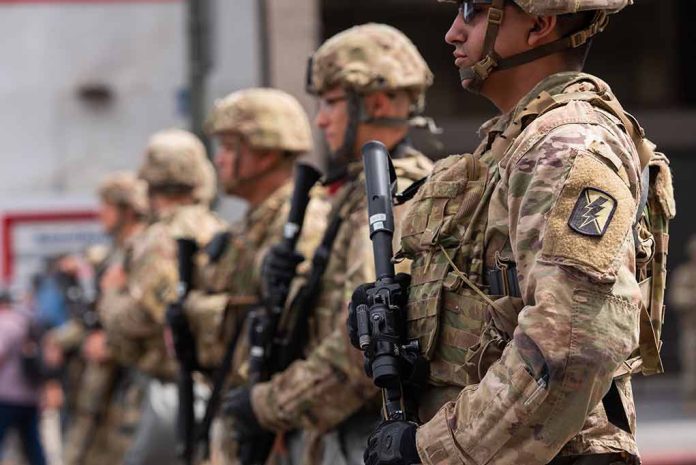
President Trump has negotiated an end to America’s billion-dollar military campaign against Yemen’s Houthi rebels after just months of operations that expended thousands of bombs but failed to stop the militant group’s attacks on vessels in the Red Sea.
Key Takeaways
- The US military operation against the Houthis in Yemen has cost taxpayers over $1 billion since March 2025, depleting around 2,000 bombs and missiles.
- Despite the massive expenditure and military effort, the Houthis continued their attacks on shipping and even targeted Israel’s main international airport.
- President Trump has negotiated a ceasefire deal through Omani intermediaries where Houthis will stop attacking US ships, though they may continue targeting Israeli and other nations’ vessels.
- The operation has resulted in significant material losses, including seven drones and two fighter jets, with questionable strategic outcomes.
- Some defense officials dispute the total cost figures, suggesting the real price tag is closer to $400 million rather than $775 million for munitions alone.
Billion-Dollar Campaign Against Houthi Rebels
The US military operation against Yemen’s Houthi rebels, dubbed Operation Rough Rider, has drained over $1 billion from American coffers since President Trump ordered the campaign on March 15 to protect American interests in the region. This massive expenditure includes approximately 2,000 bombs and missiles worth between $400-775 million according to competing Pentagon estimates. The arsenal deployed included hundreds of 2,000-pound bombs costing $85,000 each, at least 75 Tomahawk missiles at $1.9 million apiece, and approximately 20 AGM-158 cruise missiles valued at $1.5 million each.
The financial toll extends beyond munitions, with at least $10 million spent relocating two Patriot missile defense systems to the region – a figure that doesn’t account for the considerable air transport costs. Additionally, the operation has resulted in the loss of seven drones and two fighter jets, further increasing the financial burden on American taxpayers. Despite this substantial investment, the Houthis have persistently continued their attacks on shipping vessels in the strategically vital Red Sea region.
Trump’s Negotiated Ceasefire
In a significant diplomatic breakthrough, President Trump has secured a deal to suspend US strikes against the Houthis in exchange for the Iran-backed group halting attacks on American ships. The agreement, brokered with assistance from the Omani Foreign Ministry, represents a potential off-ramp for a costly military campaign that has yielded limited strategic results. However, the narrow scope of the deal means the Houthis are expected to continue targeting vessels from Israel and other nations.
“The administration was clearly looking for an off-ramp for this campaign against the Houthis,” said one U.S. official
Critics have questioned the long-term viability of this approach, suggesting that while it provides immediate relief for American shipping interests, it fails to address the Houthis’ broader disruptive capabilities in the Red Sea. The ceasefire deal comes after the Houthis demonstrated their continued operational capacity by launching an attack targeting Israel’s main international airport, even as US operations were ongoing.
Strategic Questions and Pentagon Divisions
Internal divisions have emerged within defense circles regarding both the total cost of the operation and its strategic effectiveness. Some defense officials contest the $775 million figure for munitions expenditure, arguing the actual cost is closer to $400 million. Beyond financial disagreements, there were significant differences of opinion within the administration about the scope and commitment to the anti-Houthi campaign, with some officials expressing doubts about President Trump’s willingness to sustain a long-term military strategy in the region.
“Washington has little patience and a short attention span and was unlikely to commit the resources and high-level attention necessary to see this campaign through to a meaningful outcome,” said Dana Stroul
The ceasefire negotiated by President Trump provides a pragmatic exit strategy from an increasingly costly military engagement. While the administration may claim success in protecting American vessels and restoring freedom of navigation for US ships in the Red Sea, serious questions remain about whether spending over $1 billion has fundamentally altered the security dynamics in this critical maritime corridor. Crucially, the limited scope of the agreement means the Houthis retain their capability to threaten vessels from other nations.
America’s Yemen Strategy: High Costs, Limited Gains
The scale of Operation Rough Rider represents a significant escalation from previous administrations’ approaches to dealing with the Houthi threat. President Trump intensified military operations against the group, deploying additional military assets to the region in a show of force designed to protect American interests. However, the campaign has followed a similar pattern to previous military engagements in the Middle East, with enormous expenditure yielding questionable strategic outcomes.
“The Houthis will stop shooting at U.S. ships for some period of time,” said Dana Stroul
The ceasefire agreement, while providing immediate relief from the financial drain of ongoing operations, fails to address the root causes of Houthi hostility toward Western shipping interests and Israel. Critics argue that without a more comprehensive diplomatic approach that addresses the underlying regional conflicts, particularly the tensions between Iran and its adversaries, this ceasefire may prove to be merely a temporary pause in hostilities rather than a lasting resolution to the security challenges in the Red Sea region.



